
The Battle of Cedar Creek, or Battle of Belle Grove, was fought on October 19, 1864, during the American Civil War. The fighting took place in the Shenandoah Valley of Northern Virginia, near Cedar Creek, Middletown, and the Valley Pike. During the morning, Lieutenant General Jubal Early appeared to have a victory for his Confederate army, as he captured over 1,000 prisoners and over 20 artillery pieces while forcing 7 enemy infantry divisions to fall back. The Union army, led by Major General Philip Sheridan, rallied in late afternoon and drove away Early's men. In addition to recapturing all of their own artillery seized in the morning, Sheridan's forces captured most of Early's artillery and wagons.

The Third Battle of Winchester, also known as the Battle of Opequon or Battle of Opequon Creek, was an American Civil War battle fought near Winchester, Virginia, on September 19, 1864. Union Army Major General Philip Sheridan defeated Confederate Army Lieutenant General Jubal Early in one of the largest, bloodiest, and most important battles in the Shenandoah Valley. Among the 5,000 Union casualties were one general killed and three wounded. The casualty rate for the Confederates was high: about 4,000 of 15,500. Two Confederate generals were killed and four were wounded. Participants in the battle included two future presidents of the United States, two future governors of Virginia, a former vice president of the United States, and a colonel whose grandson, George S. Patton became a famous general in World War II.
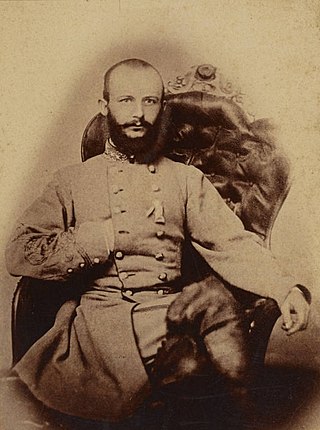
Stephen Dodson Ramseur was a Confederate general in the American Civil War, at one point the youngest in the army. He impressed Lee by his actions at Malvern Hill and Chancellorsville, where his brigade led Stonewall Jackson’s flank attack, taking 50% casualties. On the first day of Gettysburg, he dramatically routed a Union brigade, sending it running through the town, though his superiors did not authorize further pursuit. Ramseur also distinguished himself in the Overland campaign and the Valley campaign, where he was mortally wounded at Cedar Creek.
The Battle of Rutherford's Farm, also known as Carter's Farm and Stephenson's Depot, was a small engagement between Confederate forces under Maj. Gen. Stephen D. Ramseur and Union forces under Brig. Gen. William W. Averell on July 20, 1864, in Frederick County, Virginia, during the American Civil War, as part of Confederate Lt. Gen. Jubal Early's Valley Campaign, resulting in a Union victory.

The 2nd West Virginia Cavalry Regiment served in the Union Army during the American Civil War. It was organized in Parkersburg, Virginia during September 1861. Most of the original members of this regiment were from southeastern Ohio, and planners thought that this regiment would become the 4th Ohio Cavalry. Their application was rejected by the governor of Ohio, so the unit became the 2nd Regiment of Loyal Virginia Volunteer Cavalry. The "Loyal Virginia" part of the name was replaced with "West Virginia" after the state of West Virginia was officially admitted to the Union in 1863. Today, the National Park Service lists them as 2nd Regiment, West Virginia Cavalry under a heading of Union West Virginia Volunteers.
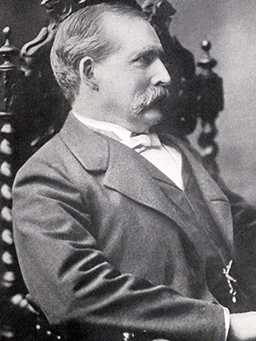
William Ruffin Cox was an American soldier and politician from the state of North Carolina. He was a brigadier general in the Confederate Army during the Civil War, a three-term member of the United States House of Representatives from 1881 to 1887, and Secretary of the Senate from 1893 to 1900.

The 26th North Carolina Infantry Regiment was an infantry regiment of the Confederate States Army during the American Civil War. The regiment was composed of ten companies that came from various counties across North Carolina and Virginia. It is famous for being the regiment with the largest number of casualties on either side during the war.

James Adelbert Mulligan was colonel of the 23rd Illinois Volunteer Infantry Regiment in the Union Army during the American Civil War. On February 20, 1865, the United States Senate confirmed the posthumous appointment of Mulligan to the rank of brevet brigadier general of U.S. Volunteers to rank from July 23, 1864, the day before he was mortally wounded at the Second Battle of Kernstown, near Winchester, Virginia. He commanded the Federal forces at the First Battle of Lexington, and later distinguished himself in other engagements in the Eastern theater prior to his death in battle.
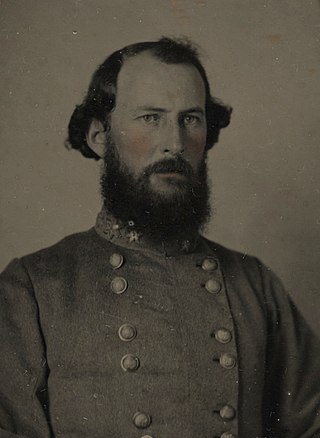
Bryan Grimes was a North Carolina planter and a general officer in the Confederate Army during the American Civil War. He fought in nearly all of the major battles of the Eastern Theater of that war.

The 1st Arkansas Infantry (1861–1865) was a Confederate Army infantry regiment during the American Civil War. The regiment was raised in April 1861 by Colonel Thompson B. Flournoy. It moved first to Virginia, but transferred back to Tennessee and served the rest of the war in the western theater, seeing action in the Kentucky, Tennessee and Georgia campaigns. Following its depletion in numbers, the regiment was consolidated several times with other Arkansas regiments, finally merging in 1865 into the 1st Arkansas Consolidated Infantry Regiment. There were three regiments known as "1st Arkansas" during the war. The second unit with the designation of "1st Arkansas" was the 1st Infantry, Arkansas State Troops, which was mustered into Confederate service at Pitman's Ferry, Arkansas, on 23 July 1861, under the command of Colonel Patrick Cleburne; this unit was eventually redesignated as the 15th Arkansas Volunteer Infantry. The third unit bearing the title "1st Arkansas" was the 1st Arkansas Volunteer Infantry, which served with the Union Army.

Henry King Burgwyn, Jr. was a Confederate colonel in the American Civil War killed at the Battle of Gettysburg.
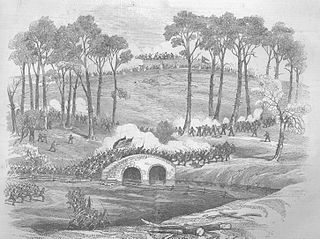
The 21st Massachusetts Infantry Regiment was an infantry regiment in the Union Army during the American Civil War. It was organized in Worcester, Massachusetts and mustered into service on August 23, 1861.
Hispanics in the American Civil War fought on both the Union and Confederate sides of the conflict. Not all the Hispanics who fought in the American Civil War were "Hispanic-Americans", in other words citizens of the United States. Many of them were Spanish subjects or nationals from countries in the Caribbean, Central and South America. Some were born in a US Territory and therefore did not have the right to US Citizenship. It is estimated that approximately 3,500 Hispanics, mostly Mexican-Americans, Puerto Ricans and Cubans living in the United States joined the war: 2,500 for the Confederacy and 1,000 for the Union. This number increased to 10,000 by the end of the war.

The 4th North Carolina Infantry Regiment was a Confederate States Army regiment during the American Civil War, active from 1861 until the war's end in April 1865. Ordered to Virginia, the unit served in General Winfield S. Featherston’s, George B. Anderson’s, Stephen D. Ramseur’s, and William R. Cox’s Brigade. Its field officers were Colonels George B. Anderson, Bryan Grimes, Edwin A. Osborne, and James H. Wood; Lieutenant Colonels David M. Carter and John A. Young; and Majors Edward S. Marsh and Absalom K. Simonton. It was nicknamed "The Bloody Fourth" after the high rate of casualties at the Battle of Seven Pines.
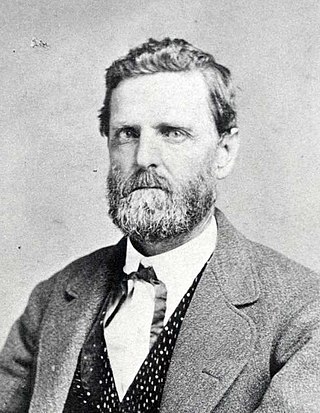
John Crawford Vaughn was a Confederate cavalry officer from East Tennessee. He served in the Mexican–American War, prospected in the California Gold Rush, and participated in American Civil War battles including First Manassas, Vicksburg, Piedmont and Saltville.
The 56th North Carolina Infantry Regiment was an infantry regiment that served in the Confederate Army during the American Civil War.

The 1st North Carolina Infantry Regiment was an infantry regiment of the Confederate States Army during the American Civil War. As part of the Army of Northern Virginia it fought in the Eastern Theater until the surrender at Appomattox.

The 2nd South Carolina Infantry Regiment, also known as 2nd Palmetto Regiment, was Confederate States Army regiment in the American Civil War.

The Battle of Lewisburg occurred in Greenbrier County, Virginia, on May 23, 1862, during the American Civil War. A Union brigade commanded by Colonel George Crook soundly defeated a larger Confederate force commanded by Brigadier General Henry Heth. Panicked Confederate forces escaped by crossing and burning a bridge across the Greenbrier River.

The Battle of Fayetteville occurred in Fayette County, Virginia, on September 10, 1862, during the American Civil War. A Confederate army, consisting of multiple brigades commanded by Major General William W. Loring, drove away a Union brigade commanded by Colonel Edward Siber. The battle was part of the Kanawha Valley Campaign of 1862, and should not be confused with the Battle of Fayetteville fought in Arkansas.














